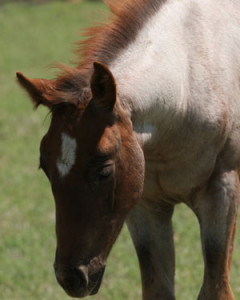 Know the basics of horse color genetics so you can easily determine your newborn foal’s color.
Know the basics of horse color genetics so you can easily determine your newborn foal’s color.
Legend says that a red horse is fiery, a dun is tough and a white-legged horse is bad-footed.
However, the wisest horsemen also say there is no such thing as a good horse that’s a bad color.
There are 17 recognized American Quarter Horse colors: chestnut, sorrel, black, brown, gray, bay, palomino, buckskin, cremello, perlino, white, dun, red dun, grullo, red roan, bay roan and blue roan.
All of them are derivatives of two base colors. Simply put, any color of horse you can think of is either black-based or red-based.
All other colors – bay, gray or roan, etc. – are just modifications of these two basic colors. Genetics is a complicated subject. So, let’s start with the basics.
Are you wondering what coat color possibilities are in store for your future foals? With AQHA’s FREECoat Color Genetics report, you can gather the knowledge you’ll need to make an educated guess about your foal’s color. Download the report today and become a coat color expert!
Base Horse Colors
All horse colors are caused by one or both of two pigments. One is responsible for black, and the other for red, ranging from yellow to dark red. White hair results from an absence of pigment. A horse with pink skin lacks pigment and gets the pink color from blood vessels under the surface of the skin. The exception is perlinos and cremellos, which have pigment, but it’s diluted.
The first rule in identifying a horse’s color is to ignore the white markings. They are different from base colors, like icing on a cake. Of the two base colors, black is a dominant color, and red is recessive. This means that a black horse will appear black whether it has two copies of the black gene (homozygous) or one black and one red gene (heterozygous). A horse will only appear red if it has no copy of the black gene.
A black-based horse is any animal that exhibits black on the points (ears, mane, tail and legs), or is solid black. A red horse won’t have any black on the points, even if the mane and tail appear dark or black.
Learning about horse genetics can be so much fun! Continue the fun with AQHA’s FREE Coat Color Genetics report. Download the report today to uncover the infinite color possibilities of your future foals.
Some black horses can become sun-faded and appear to have a brown tint to their coat, but genetically are black. It can be hard to differentiate between brown and black horses. Brown horses can appear so dark as to be nearly black but are given away by brown or tan hairs, usually around the muzzle and groin area of the horse.
The red-based colors are sorrel, chestnut, palomino, cremello, red roan and red dun.
Keep reading for some important notes on horse color.


You must be logged in to post a comment Login